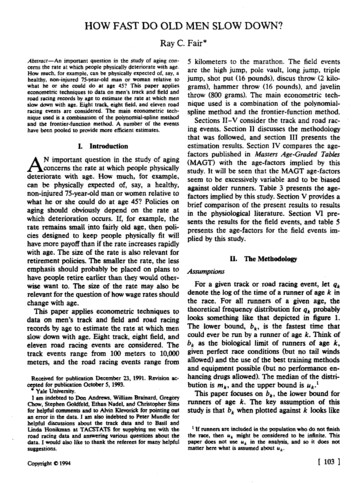
Transcription
HOW FAST DO OLD MEN SLOW DOWN?Ray C. Fair*Abrtmcr-Animportant question in the study of aging concerns the rate at which people physically deterioratewith age.HOWmuch,for example.CB be physically expected of, say, ahealthy, non-injured 75.year-old man or woman relative towhat be or she could do at ape 4% This paper applieseconometric techniques to data on men’s track and field androad racing remrds by age to estimate the rate at which mensknv down with asc. Eight track. eight field. and eleven roadracing events me considered. The main econometric technique usad is a combination of the polytwmial-spline methodand the frontier-function method. A number of the evetttrhave been pooled to provide more et%cient estimates.1.IntroductionN important question in the study of agingconcerns the rate at which people physicallydeteriorate with age. How much, for example,can be physically expected of, say, a healthy,non-injured 75-year-old man or women relative towhat he or she could do at age 45? Policies onaging should obviously depend on the rate atwhich deterioration occurs. If, for example, therate remains small into fairly old age, then policies designed to keep people physically fit willhave more payoff than if the rate increases rapidlywith age. The size of the rate is also relevant forretirement policies. The smaller the rate, the lessemphasis should probably be placed on plans tohave people retire earlier than they would otherwise want to. The size of the rate may also berelevant for the question of how wage rates shouldchange with age.This paper applies econometric techniques todata on men’s track and field and road racingrecords by age to estimate the rate at which menslow down with age. Eight track, eight field, andeleven road racing events are considered. Thetrack events range from 100 meters to 10,000meters, and the road racing events range fromAReceived for publication Deambcr 23, 1591. Revision ac.-cdlot pttblication October 5,19!23.l YakUniversity.I am indebted tt Don Andrew, William Brainard, GregoryChow. Stephen Goldfeld, Ethan Nadel, and (3hristopherSimsfor helpful mmmcntsand ta Alvin Kkwnick for pointing outan crmr in the data.I am also indebtedto Peter Mundle farhelpful discussions about the track data and to Basil andLinda Honikman at TACSTATSfor sup lyins me with themad racing data and answering vmioua qttestionr about thedata. I would also like to thank the refereesfor rn lly helpfulsuggestions.&pyrisht Q 19945 kilometers to the marathon. The field eventsare the high jump, pole vault, long jump, triplejump, shot put (16 pounds), discus throw (2 kilograms), hammer throw (16 pounds), and javelinthrow (800 grams). The main econometric technique used is a combination of the polynomialspline method and the frontier-function method.Sections II-V consider the track and road racing events. Section 11 discusses the methodologythat was followed, and section III presents theestimation results. Section IV compares the agefactors published in Masfers Age-Graded Tables(MAGT) with the age-factors implied by thisstudy. It will be seen that the MAGTage-factorsseem tobe excessively variable and to be biasedagainst older runners. Table 3 presents the age‘factors implied by this study. Section V provides abrief comparison of the present results to resultsin the physiological literature. Section VI presents the results for the field events, and table 5presents the age-factors for the field events implied by this study.II.The MethodologyAsWnlpttiFor a given track or road racing event, let Q*denote the log of the time of a runner of age k inthe race. For all runners of a given age, thetheoretical frequency distribution for qr probablylooks something like that depicted in figure 1.Tbe lower bound, b,, is the fastest time thatcould ever be run by a runner of age k. Think ofb, as the biological limit of runners of age k,given perfect race conditions (but no tail windsallowed) and the use of the best training methodsand equipment possible (but no performance enhancing drugs allowed). The median of Ihe distribution is m,, and the upper bound is uI.lThis paper focuses on b,, the lower bound forrunners of age k. The key assumption of thiistudy is that bk when plotted against k looks iike’If nmners are ittcbtdcd in the population who do not finishthe race, then ut might be catridered to be ittfinitc. Thispaper dots not use u* in the anaiysis, and so it does notmatter here what is sJsut,,ed about u*.I103 I
104THE REVIEW OF ECONOMICS AND STATISTICSk, and quadratic after that. At k,, the linear andquadratic curves are assumed to touch and tohave the same first derivative. The specification isb, o, a,ki a3 u,k a,k fork, s k s k,fork k,,(1)with the restrictions(I u, ask:a4 % - 2n5k,.that depicted in figure 2. (Remember that timesare measured in logs, so the rates of change arepercentage rates of change.) bk is assumed to beinfinite for small babies, to fall to some minimumat age k,, to stay at this minimum to age k,, andthen to begin to rise. After b, begins to rise (atk,), the rate of slowing down is assumed to beconstant through age k, and then to begin torise. k* in the figure is the oldest age at whichanyone could finish the race.The purpose of this paper is to estimate thefunction in figure 2 from some time after age k,on. The starting age used in the empirical work is35, which means that k, is assumed to be lessthan or equal to 35. k, need not be equal to 35.If it is less than 35, this just means that thesample used in this paper picks up the lie sometime after k,.Thefunctional form in figure 2 is assumed inthe empirical.work to be linear between k, and(2)The tworestrictions force the curves to touch andto have the same first derivative at k,.’ Theunrestricted parameters to be estimated are a,,as, us, and k,.It should be stressed that there is no theoretical reason for expecting the curve in figure 2 tobe linear between k, and k, and quadratic afterthat. This study is primarily a curve fitting exercise. After some experimentation, it turned outthat the assumption that the curve is linear between k, and k, and quadratic after that seemedto be adequate for fitting the data fairly well.Note that k, is estimated along with the otherparameter, and so the data are allowed to decidewhere the switch from linear to quadratic occurs.If, for example, the curve was in truth quadraticfrom k, on, the estimate of k, would likely bevery close to k, (which,as noted above, is takento be 35 here).In the initial experhnentation, three otherfunctional forms were tried. First, the quadraticin (1) was replaced with b, a3 u,/(k - a,)for k k,. The use of this form did not generallylead to as good fits as did the quadratic, and thecurvature seemed too extreme at the top ages.Second, the quadratic was made more general byreplacing the exponent 2 with a coefficient (06) tobe estimated: bk a3 a,k a,k”r. This allows the cumture to be either more or lessextreme than that implied by the quadratic. Thiidid not work because the estimates of or and o6were too collinear for any mntidence to be placedon the rest&s. The estimates of o6 were generally around 2, with large estimated standard errors. Finally, two linear segments were allowedbefore the quadratic took over, one between k,
HOW FAST DO OLD MEN SLOW DOWN?and k, and one between k, and, say, k,. The twolinear segments were restricted to touch at k,,and both k, and k, were estimated. This specification did not work for the individual eventsbecause the estimates were too collinear, butestimates were obtained for the pooled regression. The results for the pooled regression arereported below. It will be seen that the addedgenerality of two linear segments had only aminor effect on the overall results.The DataThe track data are from Masters Age Recordsfor 1990, and the road racing data are fromTACSTATS/USA. The track data give the current world record by age for each event. The roadracing data give the current best time by anAmerican for each event. (Data on world recordsby age are not yet available for road racing.) Letr, denote the fog of the observed record time forage k for a given event, and let lL denote thedifference behveen r, and the unobserved b,. rtcm thus be written:rk -b, c,.(3)tl is the measurement error for r,.In principle l can be either negative or positive, although negative measurement error doesnot seem likely. Two possible reasons for negativemeasurement error are (1) the true distance ofthe race is shorter than the stated distance, and(2) the time is recorded too low. These kinds oferrors are likely to be small because the races andrecords are monitored closely.The story is different, however, regarding positive measurement error. The relevant question toconsider is how many races for a given event haveto be run by runners of age k before r, becomasa good estimate of b,? Let Nk denote the (unobserved) number of men age k who have run theparticular event in question up to the currenttime. If Nk is in the millions, as it may be forrunners in their 30s and 4Os, there is probably agood chance that one has sampled close to thetheoretical lower bound. If, on the other hand,Nx is only in the thousands or tens of thousands,as it probably is for very old runners, one is notlikely to have sampled close to the lower bound.In fact, it is commonly stated that there are now10smany more runners, say, age SO than there usedto be, and as these runners age, the age recordsare likely to fall considerably. In 1989, nine agerecords in the 100 meters were broken, six ofthese for ages over 80. Eleven age records in the10,000 meters were broken, seven of these forages over 60. Results for other events are similar.3T’he large number of records broken in a singleyear indicates that the lower bound is far frombeing observed for many ages. This problem ofnot having a large enough sample at the higherages to get a good estimate of the lower boundwill be called the “small Nk” problem.4 Put another way, this problem is simply an order-statistic sampling problem.Two adjustments were made in the data to tryto account for the small N* problem. First, thekey assumption of this study is that after age k,,b, is greater than b, ( for i positive (men slowdown with age). Given this assumption, if r, isgreater than rXti for any positive i, r, must havea relatively large positive measurement error *ssociated with it. Observations of this kind, wherethe time for a given age is greater than the timefor some older age, were not used.Sewnd, observations at very high ages werr notused. The ages not used were always over 78 andin most cases over 81. The highest age used was89, for 100 meters. An age cutoff was made at thepoint where there was a large increase in therecord time from one age to the next relative tothe sizes of the previous increases. In discardingobservations above the cutoff it is implicitly assumed that the slow times are due to the smallNk problem and not to the fact that there isachtaily a large jump at that age. In other words,the problem is assumed to be a sampling problem, not a biological characteristic.These two adjustments may not be enough tocompletely eliminate the small Nk problem, andso the following results may be biased in thesense of overestimating the slowdown rate, especially at the older ages. An interesting question
106THE REVIEW OF ECONOMICS AND STATISTICSfor future research is whether more can be donewith the current data to tly to adjust for the smallNI problem. It is the case, for example, that Nkis likely to be a decreasing function of k and thatcc is a decreasing function of Nk. Therefore, E is likely to be an increasing function of k. Theapproach taken in this study in dealing with thisproblem is simply to truncate the sample at thepoint where the size of the effect of k on e*appears to become large. An alternative approach would be to parameterixe the functionrelating k to cI (say ll 7, yZk y,k2 for kgreater than some value k), add this to (3). aEdtry to estimate the new parameters (7,, y2, y3, k)along with the others. The data may not be goodenough to allow anything sensible to come out ofthis, but it is a possible area for further research.Another possible approach is the following.Denote the density function in figure 1 for agiven age k as f(q*.0,),where qk is the log ofthe time in the event of an individual of agek and 8, is a vector of parameters. Let qpl”denote the minimum value of qk in a sample ofis an order statistic, and letsixe N*. qyg(q,n’“, 8 t , Nkl denote its density function. Thefunctional form of g depends, of course, on thefunctional form of f. The data used in this studyare observations on qp for k 35 and over.Gii (1) observations on qp”, (2) an assumptionabout the functional form of f, (3) a parameterization of the elements of 8, as functions of k,and (4) values for Nk or a parameterization of Nkas a function of k, one could estimate the parameters by maximum likelihood. Again, the datamay not be good enough to allow sensible estimates to be obtained using this approach, but it isanother possible area for further research.Until further work is done, the present resultsshould be interpreted with caution. If the sameestimation is done ten or twenty years hence, it islily that the estimated slowdown rates will besmaller than the currently estimated rates.Whether they will be only slightly smaller or a lotsmaller is an important open question.Note finally that if all ages are getting betterover time (say because of better nutrition, bettertraining methods, or better equipment), this willnot affect the estimated slowdown rates as long asall ages are getting better at the same rate.Progress like this will affect the estimated slow-down rates only if it differentially affects thevarious ages.The EconometricsLet d, 1 if k 5 k, and d, 0 if k k,.Using this notation, substituting (1) into (31, andusing the restrictions in (2) yields the equation tobe estimated:r, u, n,k ‘ (1- d,)x(k:- 2k,k k’) Ed,k 35,.,K.(4)There are four parameters to estimate, al. ,u5, and k,, where it should he remembered thatd, is a function of k,. K is the oldest age in thesample period. There are age gaps in the sampleperiod because of the exclusion of observationswith dominated times.Let i* be the predicted value of r, from equation (4) for a particular set of coefficient estimates. The main interest in this study is in thederivative of ?* with respect to k. This derivativeisai,/ak & 26,(1 - d,)(k- i3),(5)where a hat over a coefficient denotes its estimate. This derivative is not a function of theestimate of the constant term ul in (4), and sothe size of the mnstant term is not of directconcern here.Equation (4) pertains to a particular event. Ifone is willing to assume that 1 .as, and k, arethe same across events, then the data on thedifferent events can be pooled and more efficientestimates obtained. It does not seem unreasonable that the derivatives are the same at least forevents close to each other in distance. When thedata are pooled, different constant terms areneeded for each event, since these obviously varywith distance. When the data were pooled for theresults below, the following equation was estimated (n is the number of events pooled):rrr BrD,;, . . . B.Rit 4 a,(1 - di,)(k;- 2k,k k*) lirt,i-l I., n;k-35,., Ki, (6)where rik is the log of the observed record forevent i and age k, Djit is a dummy variable that
HOW FAST DO OLD MEN SLOW DOWN?is equal to one when event i is equal to j andzero otherwise (j 1,. . , n), di, 1 if k s k,and di, 0 if k k,, cik is the measurementerror for event i and age k, and K, is the oldestage used for event i. Again, there arc age gaps inthe sample period for a given event because ofthe exclusion of dominated observations. The njSi coefficients in equation (6) are the n differentconstant terms.Return now to the estimation of equation 14).Since positive measurement error for rk is moreIikely than negative measurement error, the meanof elr is Iikely to be positive. If there is nonegative measurement error at all, then lL 2 0for all k. A positive mean for ex poses no @robIem in the estimation of equation (4) because thepositive mean is merely absorbed in the estimateof the constant term. If the mean of lL is g,define e; Ed - Z, where e; has mean zero.Equation (4) can then be rewritten with e: replacing eL and the constant term changed fromo, to a, Z. In this case a, is not identified, butthis is of no concern here because the derivativesdo not depend on (I,. One can thus estimate (41by nonlinear least squares in the usual way. Thisestimation procedure will be called the NLS procedure.There is, however, another estimation methodthat is of interest to consider. Under the assumption that c* 2 0 for all k, equation (4) can beestimated under the restriction that all estimatedresiduals are non-negative. This procedure iscommon in the estimation of frontier productionfimctions-see,for example, Aigner and Chu@6&?)and Schmidt (1976). The one added complication here is that equation (4) is nonlinear incoefficients. For Iinear equations the estimationproblem can be set up as a quadratic programming problem and solved by standard methods,but for nonlinear equations some other procedure must be found.The procedure used for the results below is thefollowing. In the standard case the coefficients inequation (4) are estimated by minimizing the sumof squared residuals X s&. Instead, one can. . .mmmuze a wetghted sum Z:,“ ,A& where A, isequal to 1 if & r 0 and is equal to a numbergreater than one if ZI 0. This penahis negative errors more than non-negative ones. For thework below a value of 1OQwas used for A, when107tx was less than zero. This was large enough tomake nearly all the estimated residuals non-negative at the optimum.5 This estimation procedurewill be called the “frontier” procedure.it turns out, as will be seen below, that theuse of the frontier procedure instead of theNLS procedure has only a small effect on theestimated slope coefficients and thus on the estimated derivatives. The use of the frontier procedure primarily affects the estimate of the constantterm, which is not of concern here.An attempt was also made to estimate theparameters of (4) under the assumption that etfollows a gamma distribution, as discussed inGreene (1980). The use of this distribution hasthe advantage of allowing the statistical properties of the maximum likelihood estimator to bereadily obtained, which the procedure discussedabove does not. It also accommodates quite flexible shapes of the error distributions. Unfortunately, sensible results could not be obtainedfollowing this approach. The estimates of the hvodistribution parameters (P and A in Greene’s(1980) notation) were usually not sensible, andconvergence was hard to obtain. It would beinteresting to see in future work if this approachcould be made to work, but the effort so far(which was considerable) was not successful.III.ResultsNLS EstimatesThe results of estimating the equation for eachevent by itself are presented first in table 1 (linesl-17). The estimates of or, k,, and rrs and theirestimated standard errors are presented alongwith the implied values of the derivatives at agesSO, 60, 75, and 95. (The implied value of thederivative for ages below is is &.I The estimation technique for these results is NLS.Set aside for the moment the 100 meter, 200meter, and marathon events. 01 the remainingfourteen events, two stand out as being cortsiderably different from the rest in table 1: 1OJKlO
THE REVIEW OF ECONOMICS AND STATISTICS108L-THET*BLEESTIMATIONRESULTSFOR ME TRACK AND ROAD RXING EVEN-IXDerivative at AgeLineSE@,)o 087.w92Road 2.000ii.ocQ12:182212::82::ai81ai787879& 0meter8 and 5K.s For 10,fKlOmeters there is asmall estimate of qs, which means that thederivatives grow vary siowiy with age. For 5K theoppositeis true. Note in particuiar that 10,000meters is quite different from 1OKeven though itis the same distance, and Iihawise for SK and5,000 meters. It may be that the 10,005 meter and5K results refiect considerable measurement erMI, given that they are so different from the rest,The other two events that have somewhat diiferent results are 30K and 25 miles. These bothhave slightly larger estimates of (1s than the eventsbetween 400 meters and the half marathon escept for 3005 meters. Two things could be soing-:;256on here. First, it may be that at roughly the 30Kdistance, the siowdown rate at a given age be@to increase, and this is what the estimates arepithing up. Second, the results may be unreliable.The 30K and 20 mile avents are not as popular asthe others, and so there is more of a potentialsmall Nk pmblem here. The potential small Nkproblem aiso reveais itself in the fact that thesamples are small for these hvo awns (12 and 11obsetvations, respectively). The samples are smallbecause many of the records were dominated byrecords at older ages and so were discarded. Thehigh number of dominated racords probably indicates a small Nk problem. It is thus an openquestion as to whether the 3OK and 20 mileresults are capturing an increase in the siowdownrate at a given age across distances or are simplydue to a small sample problem.
HOW FAST DO OLD MEN SLOW DOWN?The remaining five track events (400 metersthrough 5,ooOmeters) and five road racing events(10K through the half marathon) give similarresults. There is no evidence of anything varyingin a systematic way across distances. The impliedderivatives at age 60 across the fen distances arein remarkably close agreement; the range is only0.0100 at 10 miles and 20K to 0.0114 at 3000meters. There is more variation in the estimatesof a:2, where the range is 0.0042 at the halfmarathon to 0.0087 at SO00meters. The range atage 7.5 is 0.0134 at 10 miles to 0.0186 at 3000meters, and the range at age 95 is 0.0180 at 10miles to 0.0281 at 3000 m rs. The estimatedstandard errors for GE,and k, are fairly large forsome events.Given that no systematic variation across distances is evident in the ten events, it seems sensible to pool them to obtain more efficient estimates. The results of doing this are reported inlime 18 in table 1. The estimate of n2 is 0.0069,with an estimated standard error of 0.0006, andthe estimate of k, is 47.7, with an estimatedstandard error of 3.0. The derivatives are 0.0076at age 50, 0.0109 at age 60, 0.0157 at age 75, and0.0221 at age 95.7These pooling results are not sensitive to theexclusion of the 10,000 meters, 5K, 3OK, and 20mile events. When the observations from theseevents are included in the pooling, the estimatesof o2 and k, are 0.0069 and 48.3, respectively,and the derivatives at ages JO, 60, 75, and 95 are0.0075, 0.0109, 0.0159, and 0.0227, respectively.‘Under the assumption that lt is normally distributed.which cannc t be quite right because of the truncation issues,an F-test can be used to test the hypothesis that CC*.q, andk, are the same across the ten wents. There arc 27 restrictions, and the number of observations in the pa&d regression is 256. The Fnlucwas 2.17. which compares with thecritical value at the 1% level of 1.82, and so the hypothesis isrejected. Similar results were obtained when other se*i ofevents were used. The hypothesis that the mflidents are thesame across the specified events was usually rejccte& although the computed F-values were usudiy “01 too muchabove the critical values. Cfl e hmthesis that the coefficientsare the mmc for MK and 20 miles was, however, not rejected81 the 5% level.)I am not inclined m take these rejections as strong evidenceagzdnst pooling. Tbe Eomputcd F-values were never taa faxfrom not rejecting the null hypothesis; the sample size is smallrelative to the number of restrictiow and there scans to beno compelling reason for believing that the coefficients changeacmss the particular events, especially since no systematicpatterns across the ten events were evident when the aqua(ions were estimated individually.109These estimates are very close to the estimatespresented in table 1 when the four events areexcluded.Consider now the 100 meter, 200 meter, 3OK,20 mile, and marathon events. For 100 meters theresults indicate that the rate of slowdown issmaller than it is for the other events. The estimated age at which the quadratic takes over issimilar for 100 meters versus the pried sample(46.5 versus 47.71, but the sizes of the derivativesare smaller. For example, at age 60 the slowdownrate is 0.0083 compared to 0.0109 for the pooledsample. At age 95 the rate is 0.017s compared to0.0221 for the pooled sample.The results for 200 meters are quite differentfrom the rest. Tbe estimated age at which thequadratic takes over is 65.8, which is much higherthan the other estimates. Also, the estimate of n,is much larger, which means that once thequadratic takes over, the estimated increase inthe slowdown rate is larger than it is for the otherevents. The derivatives at age 60 are similar for100 and 200 meters, but the derivative is noticeably larger at age 75 for 200 meters and considcrably larger at age 95 (0.0403 versus 0.0175). Because the 200 meter results stand out as beingmuch different from the rest-both from the 100meter results and from the results for 400 metersand above-they should be interpreted with considerable caution. It seems likely, for example,that the increase in the slowdown rate after age64 has been overestimated.Given that the results for 30K and 20 miles aresimilar to each other and differ somewhat fromthe rest, it is of interest to pool the two events.The results of thii pooling are presented in line19 in table 1. Comparing lines 18 and 19, it canbe seen that the estimated slowdown rate for 30Kand 20 miles is lower at the younger ages andhigher at the older ages. Although nof shown inthe table, the age at which the slowdown ratebecomes greater for 3OKand 20 miles is about 59.By age 95 the estimated slowdown rate is 0.0299for 30K and 20 miles versus 0.0221 for rhe others.The results for the marathon in line 17 continue the pattern of the estimated slowdown ratebeing lower at the younger ages and higher at theolder ages. Although not shown in the table, theage at which the slowdown rate becomes greaterfor the marathon compared to the pooled eventsin line 18 is about 63. The estimated age at which
110THE REVIEW OF ECONOMICS AND STATISTICSthe quadratic takes over is 58.2, which is higherthan all the other estimates except the one for200 meters. The estimate of a2 is 0.0063, whichmeans that until age 58 the estimated slowdownrate is constant at 0.63% per year. After age 58the estimated slowdown rate picks up fairlyrapidly (the estimate of crs is large), and by age95 the derivative is by far the largest of any eventat 0.0515. This derivative is even much largerthan the derivative for the 30K and 20 mileevents.The differences between the marathon derivatives and the other derivatives at the older agesare large enough to make one question whetherthe marathon results should be trusted. Theremay be, however, more to the marathon than amere 6.2 miles beyond 20 miles. Anyone who hasnm the last 6.2 miles in a marathon can appreciate this. If there is an important nonlinearity ingoing from 20 miles to the marathon, one mightexpect there to be a more rapid increase in therate of slowing down at older ages for themarathon. This is what the current results show,although the estimated size of the effects shouldbe taken with considerable caution.Frontier EstimatesThe final estimates in table 1 were obtainedusing the frontier procedure. Results are presented for 100 meters, 200 meters, pooled 400meters through the half marathon, pooled 30Kand 20 miles, and the marathon. The resultsusing the frontier procedure are quite similar tothe other results. None of the comparisons andmnclusions discussed above are changed by thefrontier results, although the results for 200 meters (line 21) are somewhat less utreme using thefrontier method than they are using NL,S.Figure 3 presents plots of actual and prediaedvalues for four events-100 meters, 200 meters,5000 meters, and the marathon. The actual valuesare the values used in the estimation, and so theydo not include the dominated values (which wereexcluded) and the values excluded at the highages. The predicted values are from the fmtttierestimates. For 100 meters, 200 meters, and themarathon, the frontier estimates are presented inlines 20, 21, and 24, respectively, in table 1. Thefrontier estimates for 5lXMlmeters were obtained,but they are not presented in table 1.The plots for 100 meters and 5000 meters showthat the curvature for the quadratic is quite modest once the quadratic takes over. The plo
HOW FAST DO OLD MEN SLOW DOWN? 10s and k, and one between k, and, say, k,. The two linear segments were restricted to touch at k,, and both k, and k, were estimated. This speci- fication did not work for the individual events because the estimates were too collinear,










